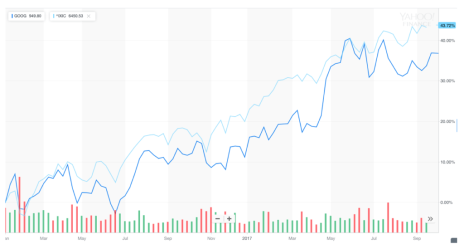The investment industry eats data for breakfast, lunch and dinner, and if you can think of a statistical way to describe the stock market, you can bet that someone has found a way to measure it, analyze it and sell it. And growth investors are no slouches in the data consumption business. After all, one of the data points that I use to help make investment recommendations is a growing number of institutional investors. I use a rising number as evidence of an indirect seal of approval from the big investment houses. And right now, a certain FANG stock has a surprisingly low approval rating. I’ll tell you which one in a minute.
This FANG Stock Is Becoming Unloved
I got interested in which stocks are the most widely held by institutional investors, and with just a little searching, I found a couple of different answers. The one that made the most sense to me was a report by eVestment, a company that slices and dices market data for asset managers, hedge funders and consultants.
[text_ad]
eVestment tells me that the most popular stock in the portfolios of institutional investors at the end of the second quarter of 2017 was Microsoft (MSFT), which was owned by 21.6% of all portfolios, followed closely by Alphabet (GOOG), with just a hair less at 21.3%. And the list goes on with Apple (AAPL), J.P. Morgan Chase (JPM) and so on.
The big news in the latest eVestment report was that Home Depot (HD, 12.8%) and Citigroup (C, 12.8%) had replaced Verizon (VZ) and Royal Dutch Shell (RDS) in the top 20 most-popular holdings. I could hardly contain my excitement.
But what really piqued my interest was a news story from two years ago that showed Google (now renamed Alphabet, and a so-called FANG stock along with Facebook (FB), Apple and Netflix (NFLX)) in the lead in portfolio inclusion with 30.3%.
Dropping from first position to second position isn’t big news, but the news that GOOG’s inclusion rate had dropped from more than 30% to just over 21% was food for thought.
Growth Stock Performance: It’s All Relative
As usual, a quick look at a chart told me what I wanted to know. What I found was that the other stocks with big institutional sponsorship were actually outperforming the S&P 500 since the beginning of 2016, but GOOG wasn’t—the only FANG stock that has fallen short of the market the last two years.
Here’s a chart showing GOOG stock versus the S&P for that period. (GOOG is the darker blue line and the S&P is the lighter).
You can see that GOOG lagged the S&P for much of the period, made a big run in April and May of this year to surge ahead, and has been stalled out since then while the S&P has run on ahead.
Keep in mind that the biggest holdings in the top-holdings list are there because they are solid businesses that offer an attractive combination of liquidity, price appreciation and (often) dividends.
And all I have to offer in the way of advice is that it is always a good idea to take a look at how a stock you are interested in is doing against a popular index to get an idea of its real strength. If the stock is only rising as fast as the broad market (the S&P 500, for instance), you’re not getting much advantage by buying it instead of a lower risk index fund. If you’re going to take on the additional risk of buying an individual stock (which I whole-heartedly recommend!), you need to see that momentum (and higher relative performance) is on your side.
Where to Find the Market’s Strongest Stocks
And if you’re interested in finding stocks that are outperforming the market, I would suggest Cabot Top Ten Trader, an advisory that comes out every Monday, after the market closes, and will give you the 10 strongest stocks of the previous week, including a buy range and a suggested defensive stop. Stocks qualify for inclusion in Top Ten by featuring strong fundamentals, an attractive story and a chart that shows real strength. And like all stocks that appear in Cabot advisories, there is useful follow-up on featured stocks that fall into their buy ranges within two weeks.
For growth investors, there’s no more reliable source for information about up-and-coming stocks as well as perennial favorites that are showing new strength. You can get more information about finding the strongest stocks in the market by clicking here.
[author_ad]

